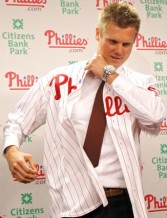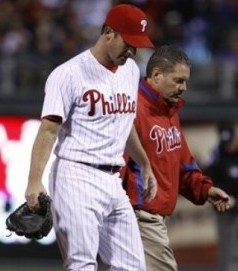Two of the most influential members of the Yankees’ front office took to the airwaves this morning to promote the upcoming Pinstripe Bowl, and not surprisingly, each interview touched on the team’s offseason plans. President Randy Levine, who was a guest on FOX 5’s Good Day New York, and COO Lonn Trost, who appeared on WFAN’s Boomer and Carton morning radio show (hosted by Kim Jones and Chris Carlin), each fielded several questions about what the Yankees are doing, or not doing, and their responses suggested the organization has a coherent party line.

Randy Levine (l) and Lonn Trost (r) flank Derek Jeter during a ceremony honoring his 3,000th hit. (Photo: Getty Images)
Responding to the question about whether the team’s spending philosophy has changed, Trost dismissed the idea that the Yankees were being more cautious, but stated that the team was trying to be smarter. According to Trost, the Yankees do not believe the dollars being spent in the current market are commensurate with the abilities of the players available, putting the organization in a position to depend on its minor league system. In particular, Trost cited Manny Banuelos, Dellin Betances, Hector Noesi, Jesus Montero, and Austin Romine as prospects that could make an impact next season. He also suggested that because of the team’s high expectations for those players, there hasn’t been a need to overspend as in the past.
Levine’s segment on GDNY was much shorter than Trost’s appearance on WFAN, and the hosts didn’t have the same sports background as Jones and Carlin, but there were several pointed questions about the Yankees’ winter designs. When asked about the team’s need of pitching, Levine responded that the organization was always looking to get better and that if an opportunity presented itself, Brian Cashman would be on it. Levine also touched on the Yankees’ potential interest in Cuban outfielder Yoenis Cespedes, stating that it was in the best interest of the organization to keep their level of involvement a secret.









